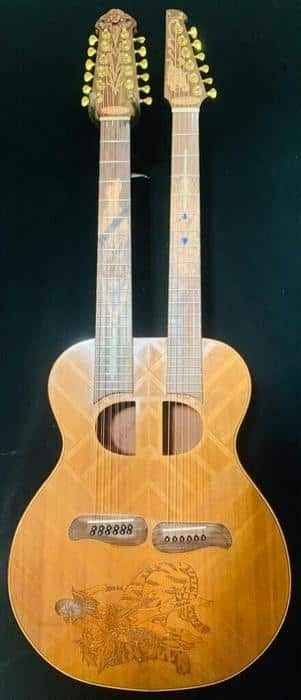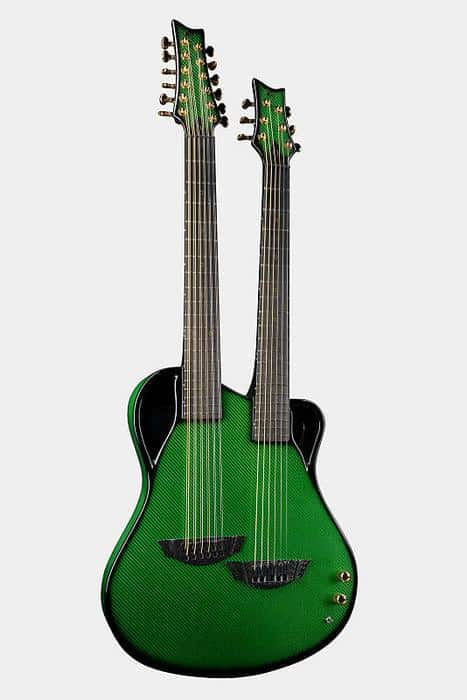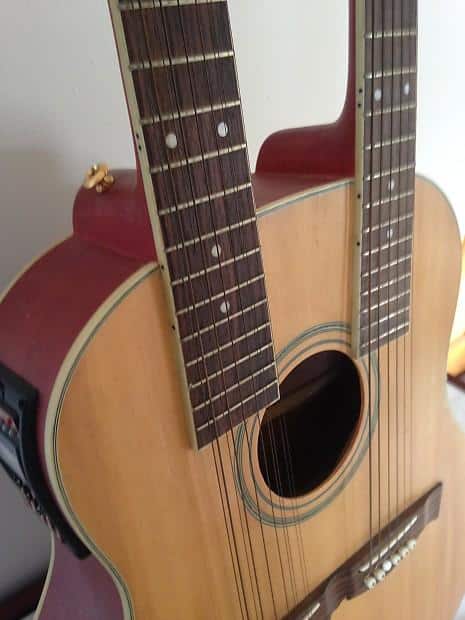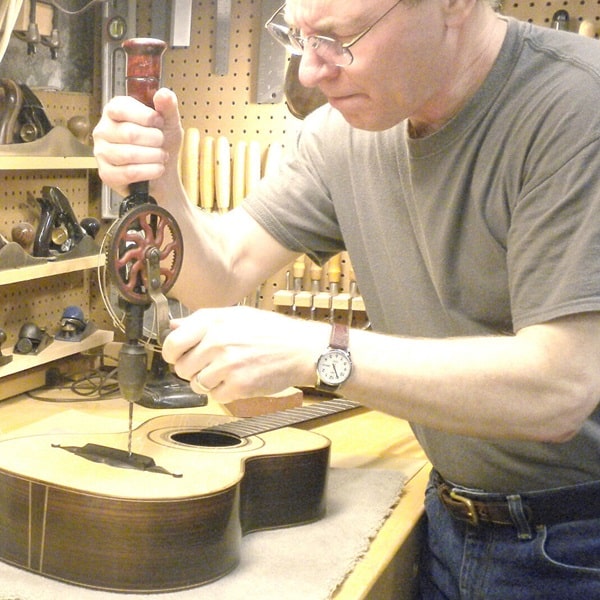Welcome, fellow guitar enthusiasts! A bold claim for you: the double neck acoustic guitar dramatically surpasses the standard six-stringed guitar in versatility, craftsmanship, and pure “wow” factor. Impossible, you say? With two necks, twelve strings, and the uncanny ability to switch musical tonality in a second’s notice, I beg to differ. Yet, how is this possible? The answer, my friends, lies further within…
From their swan-like, extended necks to the beautiful resonance of their multiple strings, double neck acoustic guitars are the epitome of breath-taking multi-stringed instruments. Truly a testament to the genius of the human mind and the passion and craft of luthiers worldwide. But just as soaring, complicated pieces of architecture, their brilliance doesn’t reveal itself at first sight.
*R.M. Mottola here, your guide into this fascinating, sometimes mystifying, world. Having traded in a life of practical engineering for over twenty years of luthier work, countless hours of tutoring, research, and hands-on experience with multi-stringed instruments, I can tell you – every discovery is an adventure, every nuance a revelation. I stand ready, my friends, not just to demystify these marvels but to embolden you to explore for yourself. Are you ready to unlock the secrets of these remarkable instruments? Will you dare to go beyond the familiar, to venture into the intriguing world of double neck acoustic guitars? If your answer is a charismatic ‘Yes!’, then read on, for the journey has just begun… *
The What: Understanding Double Neck Acoustic Guitars
Design and Functionality

Layer for layer, curve for curve and wood selection by wood selection, a guitar’s design contributes inceasingly to its functionality, and ultimately to the sound it breathes into life. Equipped with an engineering background and a deep-seated passion for guitars, I hope to simplify the complex world of dual fretboard guitars like the double neck acoustic guitar.
The double neck acoustic guitar is a wonder in itself. As the name suggests, it has two necks, typically one 6 string and one 12 string. These two contrasting but complementary guitars sitting atop one body allow a player to switch between different sounds and tones effortlessly. But it’s not just about the number of strings – the design intricacies go deeper.
The two fretboards of the double neck acoustic guitar allow for richer harmonies. With an additional set of high octave strings tuned one octave higher than their low octave counterparts, the 12-string neck produces a chorus-like, fuller sound. Switch to the 6-string neck, and you have the traditional, clear tones and flexibility for intricate solos. All of this, without the need for a second guitar.
Then there is the wood. The choice of wood massively influences the resonance of the guitar, and with two necks, double neck guitars provide the scope for additional tonality options. For example, mahogany tends to produce a warm, full tone, perfect for strumming or fingerpicking, while maple lends itself best to brighter sounds and solos, making for a versatile instrument.
Additionally, the design of the double neck acoustic guitar caters to different playing styles. For the adventurous who perform slide and steel guitar techniques while simultaneously picking notes on the other neck, to the classical players seeking the convenience of both sounds in one instrument, the dual fretboard design augments the player’s capability to create contrasting sounds at will.
Functionality, however, does not come at the cost of aesthetics or comfort. Contemporary models maintain a balance to prevent it from becoming too heavy and detracting from playability. Despite the complexity of the double neck, ease of play has remained a priority within its design evolution.
Ultimately, the double neck acoustic guitar enhances a player’s expression. The addition of a second neck doesn’t just double the number of strings; it doubles the emotional register of the player and multiplies the creativity potential. Packed with a plethora of original design features aimed at expanding a musician’s arsenals, the double neck guitar remains a testament to the harmony of design and functionality.
Moving beyond the strings and wood, let’s delve deeper into the variety of double neck acoustic guitars plying their trade across the world…
Various Models and Special Editions

As we dive deeper into understanding double neck acoustic guitars, exploring the various models and special editions is an essential journey through the diversity of this instrument’s design. Each model, each special edition, contributes unique nuances to the world of double neck acoustics. Their design aesthetics and functionality outline the limitless possibilities of guitar playing, shaping our understanding of how versatile these instruments can be.
Take, for instance, the Guild Crossroads doubleneck. This guitar’s elegant design gives as much emphasis on aesthetics as on playability. Its combination of a six-string acoustic and a twelve-string electric guitar draws admiration from both players and collectors. My personal experience with it was transformative, reshaping my understanding of what a double neck acoustic can offer.
Similarly, the Emerald Chimaera 18 string guitar completely redefines what one can expect from a double neck. With the audacious design of two nine-string guitars combined into one, playing the Chimaera feels like an adventure into uncharted territories of harmonics. This model stands testament to the ingenuity behind the creation of double neck acoustics.
Then comes the Taylor Richie Sambora Signature Koa double neck, a special edition that has over the years caught and held my fascination. This model’s unique Koa wood construction contributes to its vibrant, resonant tone, encapsulating the ideal blend of beauty and performance. Its rich sound, coupled with a unique aesthetic, makes this model a constant standout.
The exploration of these models and special editions not only enhances our knowledge but also underlines the significance of double neck acoustic guitars in shaping the dynamics of music creation. It’s exciting to see how much variation can exist within one classification of instrument, and it’s this beauty of diversity that I believe truly makes understanding double neck acoustics a compelling endeavor.
Whether you are an avid collector, a casual player, or a curious enthusiast, appreciating the variety and ingenuity behind these models and special editions is an integral part of your journey into the world of double neck acoustic guitars. And as we move forward to explore the famous guitarists and their iconic performances with these instruments, these insights will give us a richer perspective of the significance and impact of double neck acoustics in the music world.
The Who: Famous Guitarists and their Double Neck Acoustics

Peering deeper into our deep dive on double neck acoustic guitars, it’s time to focus on the Who aspect. Through my editorial services for numerous books on stringed instruments, I’ve had a chance to learn about great artists and the instruments they play. I’m excited to draw on this experience to present you with a broader picture of double neck guitar players, particularly focusing on the renowned John Mayer and Richie Sambora. The unique dynamic these artists have with their instruments plays a cardinal role in carving their signature sounds.
To frame it in a curious context, I ask: why do the likes of John Mayer and Richie Sambora opt for double neck guitars? What’s the secret sound soup they craft with these layered neck titans? Let’s delve into their stories and why these instruments are pivotal to their melodic narratives.
Initially coming into the limelight in the early 2000s, John Mayer, the seven-time Grammy award winner, has always been known for his varied guitar collection. His guitar repertoire would be incomplete without the inclusion of the double neck acoustic. Of special mention is the John Mayer double neck Martin guitar. The sheer versatility of this instrument gives Mayer a wider canvas to paint his delicate hues of blues, pop, and rock. With twelve strings on the top and six at the bottom, the guitar makes it possible for Mayer to effortlessly switch between sounds mid-song – a melody marvel if you will. This double neck Martin holds a special place in Mayer’s performances and contributes significantly to his characteristic sound.
Now let’s delve into the guitar journey of Richie Sambora, the lead guitarist of the rock band Bon Jovi. Known primarily for his contributions to rock anthems, the Ritchie Sambora model guitar is a powerhouse double neck instrument that embodies his versatile style. With a six-string and a twelve-string neck, this guitar gives Sambora the ability to switch between softer, intricate melodies and harder rock rhythms instantly. If you hear a Bon Jovi song with a noticeable guitar shift mid-performance, chances are it’s Ritchie wielding his double neck weapon. His deft manipulation of this double neck acoustic is noted as a defining feature of Sambora’s edgy rock sound.
As we traverse through the melodious journeys of these artists and their double neck acoustics, it’s apparent that the guitar is not just an instrument but an integral extension of their musical personalities. These guitars add a unique shade of versatility and musical depth to their performances. It’s a symbiotic relationship, one that shapes their signature sound and simultaneously celebrates the potential of the double neck acoustic guitar.
After delving into John Mayer and Richie Sambora’s stories, we can see that the double neck acoustic guitar’s appeal lies not only in its design and functionality but in its transformational capabilities on stage. As we move towards discussing iconic performances and events involving these guitars, remember the intricate relationship these famous guitar players have with their double neck acoustics.
The Where and When: Iconic Performances and Events

As we delve deeper into the world of double neck guitars, the dazzling spectacles of live music events like the NAMM show come to mind. Seeing virtuoso guitarists take the stage with these distinctive instruments, watching as they effortlessly navigate between not just one, but two sets of strings, has been a continuous source of awe and inspiration.
Have you ever wondered when and where double neck guitars truly shine? Get ready to revisit some groundbreaking performances that changed the course of music history. Being an active member of the lutherie community and regularly attending music trade shows, I’ve been fortunate to witness many such moments that underline the brilliance of double neck guitar performances firsthand. The following reminiscences might shed light on why these magnificent instruments are so revered in the music world.
One of the most iconic displays of a double neck guitar was by none other than Jimmy Page. In a 1971 performance with Led Zeppelin, at the Ulster Hall in Belfast, Page wielded his Gibson EDS-1275 double neck, effectively switching between the 6 and 12-string necks, leaving the audience spellbound. This performance, with Stairway to Heaven reverberating through the double neck guitar, remains etched in the annals of rock music, truly showcasing the instrument’s potential.
NAMM show guitars and exhibitions have also seen their fair share of memorable double neck guitar performances. For instance, the NAMM 2010 was unforgettable for me. There, the legendary Steve Vai unveiled his dazzling mirrored Ibanez JEM double neck, using it to execute his fast, intricate compositions showcasing his exceptional command over the instrument, the venue resonating with his distinctive sound.
Emphasizing the versatility of double neck guitars, country virtuoso Rusty Young, of Poco fame, treated audiences with his unique playing style on his double neck Gibson at the 1974 Winterland Ballroom show. By adeptly switching between the 6 and 12-string necks, he beautifully blurred the lines between country, rock, and folk genres, adding another dimension to double neck guitar performances.
To me, these noted performances emphasize the very essence of double neck guitars—their versatility, their inherent rich tone, and their capacity to push the boundaries of musical expression. Simultaneously, they reflect the extraordinary caliber and innovation of the guitarists who dared to master and publicize them.
As we continue our exploration of double neck acoustic guitars, these memories serve as vivid reminders of this instrument’s unmatched capabilities. For those pondering the ‘where’ and ‘when’ in context to double neck guitars, these moments unfold its very history and my personal journey through the landscape of music.
Now that we’ve witnessed the spectacle of iconic performances and the stages they graced, let’s shift our focus to how one can explore crafting their own double neck acoustic in the next section. A fascinating journey awaits!
The Why and How: Building Your Own Double Neck Acoustic

As we explored the world of double neck acoustic guitars, we have come across many facets of its design, functionality, its famous users, and their iconic performances. But today, in this chapter, we’re stepping beyond the realm of admiration and into the realm of creation. As someone with a deep interest in the engineering side of stringed instruments, you might have guessed I’ve dabbled a bit in construction myself. I have developed a passion for design, construction, and the science of acoustics. And truthfully, there’s no instrument I’ve found more intriguing to construct than the double neck acoustic guitar.
Did you know that building your own guitar can be a deeply rewarding journey? Ready to create a distinctive instrument that connects with your personal musical expression? That’s where we’re heading now – welcome to the world of handmade double neck guitars! Personalizing your guitar increases its significance, making it an even more intimate tool for your musical expression.
Let’s start with the why. I believe that building a custom double neck guitar encapsulates at least three passions: music, craftsmanship, and science. It allows musicians to understand their instrument beyond its sound, forging a connection of deeper comprehension and appreciation. The process unveils the acoustic science behind the melodies, the chords, the strumming. This knowledge, in turn, enhances the performance and playing technique. Also, isn’t it fascinating to have an instrument that is genuinely unique, reverberating with your artistic echo? I find it poetic and liberating.
As we venture into the how, do note that building a double neck guitar requires patience, precision, and persistence. However, it is a surprisingly accessible hobby, even for a novice. But please be warned – it can get addictive!
To begin, you need to design your guitar. Define how it should look, how it should feel – get creative. The technicalities will follow suit. As for materials, you could start with pre-cut, ready-to-assemble guitar kits, or if you’re feeling adventurous, you can start from raw lumber. Don’t forget to work in a ventilated space with the right safety gear and adequate tools.
The next step involves assembling, shaping, and sanding, making sure to be particular about precise measurements. Remember, a millimeter can make a difference in the sound. Once the structure is ready, we move on to the application of finish, be it varnish or lacquer. It defines not just your guitar’s aesthetics but also plays a role in the tonal resonance.
Finally, we reach the step of setting up the hardware – plugging in those electronics (if any), installing the bridge, and stringing your custom double neck guitar. Don’t forget the fine-tuning process afterward to attain the sound you desire. It’s a steep learning curve, but the outcome – a handmade double neck guitar – is a reward like no other.
Building your own double neck acoustic guitar is indeed a challenge, but a rewarding one. It takes time and effort but in the end, the result is a truly personal musical companion. And remember, the process doesn’t have to be solitary. There are countless guitar building communities out there that are willing to provide guidance and support.
As we pen down this section, let’s not forget that building a guitar should be fun. It’s about expression, discovery, and, yes, some serious science too. But above all, it’s about enjoying that journey towards making something truly yours. I hope you’re as excited as I am for this venture, and wish you a rewarding experience of craftsmanship, creativity, and music making.
FAQs
What are double neck acoustic guitars?
How does using a double neck acoustic guitar benefit a guitarist?
Are double neck acoustic guitars difficult to play?
What famous musicians have used double neck guitars?
Conclusion
Reflecting upon my two-decade journey as a luthier, I am connected with the essence of the double neck acoustic guitar in a way that is both intricate and profound. The meticulous craftsmanship, profound versatility, and sheer enchantment of this musical instrument are unfathomably captivating. This is not just an instrument; it’s an extension of one’s musical soul.
What if I told you that understanding and playing a double neck guitar can redefine your musical journey? Ready to join the ranks of revolutionary musicians who dance to their own tune? We’ve walked through the technicalities, surveyed an array of models, appreciated the masters who epitomize double neck excellence, and marveled at memorable performances. We’ve even scratched the surface of building one yourself.
Now, it’s your turn to take the leap, to dare to be different, to make your mark in the world of double neck guitars. Sharing this knowledge and reminiscing about my journey in the lutherie world has always been close to my heart, and wrapping this up brings a unique sense of accomplishment.
I hope this exploration of double neck guitars has ignited a passion within you, as it did in me more than two decades ago. The world of double neck acoustic guitars beckons, will you answer its call?

R.M. Mottola, an engineer-turned-luthier, revolutionizes stringed instrument design with his deep focus on acoustics and ergonomics since 1994. As editor of the Savart Journal and a key contributor to American Lutherie, Mottola merges science with artistry in lutherie. He enriches the field with his extensive knowledge, shared through his Liutaio Mottola website, making him a beacon in the world of modern instrument craftsmanship.
